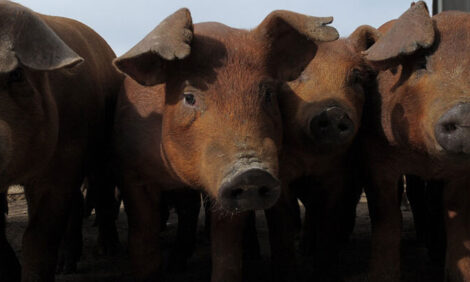



Top Profit Robbers: Nursery-Finish
Three farmers shared their views on the most important aspects of nursery to finishing management at the 2013 London Swine Conference.
James Reesor (RFW Farms Ltd, Grimsby, Ontario)
The key profit drivers in the nursery-finish segments are driven by feed efficiency, cost of gain, average daily gain, mortality, morbidity and carcass quality, said Mr Reesor. These profit driver measurements represent outcomes of other decisions.
Mr Ressor summarised some of the principles and approaches used at RFW Farms, seeking to maximise nursery-finish barn profit drivers.
Sometimes, too much effort is placed measuring outcomes without giving sufficient thought to what brings about successful performance measures in the nursery-finish barn.
*
"It is not congruent to preach animal husbandry and care while placing animals that are prone to aggression and/or having a barn environment that may stimulate aggressive behaviour."
The following outlines some key principles used at RFW Farms:
- You don't have to live in the barn but be fully mentally engaged when there.
- Fix before it is broken - equipment does not heal itself.
- Stable health is critical - health status, feed ingredients, facilities. They spend (invest) on vaccines and treatment; the author fears the term 'dial-back cost' as it relates to health spending. He said he does not want to be foolish; unnecessary health costs are also foolish. When measuring against other farms, RFW Farms tends to have higher health costs per pig produced but it is usually among the lowest for morbidity and mortality.
- Animal vices are not tolerated - at the cost, perhaps, of feed efficiency and average daily gain. The company aims for mental congruence - it is not congruent to preach animal husbandry and care while placing animals that are prone to aggression and/or having a barn environment that may stimulate aggressive behaviour. They also relentlessly seek to identify and fix the causes of any animal aggression that does occur.
- Chores are what you do before breakfast then get on with the day - no! This risks fitting the needs of caring for animals into a specific allotted time. However, since nursery and finishing barn management are not usually full-time jobs. a confusion over priorities can happen, especially when the animals are doing well and extensive additional time is not needed to care for them properly.
- Individual pig care is critical to being among the best nursery-finish operators. However, this will not overcome inattention to overall group care items such as ventilation, temperature and draught management, water management, feeder settings, equipment and building maintenance.
- Finish segment: a great deal of effort goes preparing a high-quality feeder pig. Receiving a high-quality feeder pig can make the responsibilities of managing the finishing barn appear easy. However, most of the cost of producing a market hog is allocated to the finishing segment, especially in these times of high feed costs. Hence, a great deal of responsibility rests with the finishing operator to manage all the fine-tuning aspects of this stage in order to achieve the best possible performance measures noted above.
- Successful farming should be busy but relaxing and may well include positive stresses. However, negative stress - not always on edge worrying about breakdowns, health challenges etc - must be minimised. The most successful livestock and crop producers make the job appear easy but are actually enjoying the outcomes of a great deal of planning, effort and investment.
Clare Schlegel (Schlegelhome Farms Inc)
The title 'Top Profit-Robbers Wean to Finish' assumes there is a profit and obviously long-term, otherwise no pigs will be produced. So the context of the discussion must be to minimise expenses and maximise revenue. Either one can expand the margin. The additional concept is that of a 'robber'. This leads the author to the concepts of stealing, taking things that actually belong. In the discussion, one thinks about areas that should be avoided. Often this implies areas that can easily be missed in common day-to-day activity, slipping by without much consideration and at some point in the future, realising that the margin has been 'robbed'.
*
"Feeder adjustment ... to reduce feed wastage while not limiting growth rate."
Wean to finish - around 7kg to 25kg and then around 25kg to 125kg. The obvious large expense is feed but perhaps robbers, while certainly feed, are in many other smaller areas. Often, it is tempting to think that an effect of only 25 cents per pig is small when one considers the animal at market may be worth around $175. Yet when one considers that the usual margin for this animal may be only $25, the 25 cents area is now huge. Almost everyone does the large areas well - for instance, getting the pigs fed - but many fail - including the author's operation - to do the little things, the 25 cent-areas, as they could and should be.
So here is a Top Ten list from experience rather than a scientific perspective. You could argue with any of these and you could certainly contest the priority.
- "Do the little things and the big things will take of themselves." Pay attention to the details. Ms Schlegel suggests the difference between good managers and great managers is exactly this! And perhaps this is the most difficult to teach and learn.
- Healthy animals ... PRRS, myco, strep etc ... nothing beats healthy animals. and every animal deserves daily attention and immediate response.
- Barn environment. No draughts, minimum daily fluctuation in temperature and fan-controlled barns to reduce stress.
- Proper feed. Grind size - smaller grind = better feed conversion - pelleting ration instead of mash, proper nutrition for stage of growth. Minimum cost formulation etc. We all know about this. Can we minimise input costs?
- Not surprising with feed being the largest expense and perhaps this should be number 1 ... feeder adjustment to reduce feed wastage while not limiting growth rate.
- Similar health status for co-mingling of pigs into nurseries and finishing barns. By far the best if it can be accomplished is single source or even farrow-to-finish as long as general health status is high enough.
- Maximise revenue to hitting the sweet spots on market grids. Monitor standard deviation and average index.
- Along the same lines, if you are 'all in, all out', minimise the number of days between barn fills. It costs somewhere between 15 and 20 cents per pig space per day.
- Euthanise pigs quickly. This is one of the most difficult jobs. No-one likes to kill animals yet this is the most humane option if an animal will never fully recover. Very hard to do but important.
- Target setting and records. Most of us do not like paperwork yet this is one of the most important areas. This is in both terms of costs, average prices and also in barn productivity numbers. We need to become more like the chicken industry with good industry numbers.
Jim Paton (Paragon Farms, Thamesford, Ontario)
Key drivers in the nursery and finishing stages are mainly health, cost of production and performance. Mr Paton looks into the specific things monitored at his facilities to ensure maximum profit and performance.
Nutrition
Feeding the proper amount of each feed stage to maximise performance is essential. Incorrect diets cost in terms of on under-performance or feeding too much of an expensive ration. You need to be constantly monitoring your herd and working closely with your nutritionist and veterinarian to ensure peak performance and the least-cost ration to get you there.
Feeder adjustment must also be managed to maximise performance: too tight and pigs cannot get enough feed, too open and feed is wasted.
Feed withdrawal before shipping is also important; the pigs move and load easier and you are not sending a belly full of feed to the processing plant. Also, you need to monitor feed quality - from ingredients and nutrients to particle size.
Another area to consider is split-sex feeding; if it can be done in your facilities, there is a definite advantage.
*
"Do not cut corners with treatments or vaccines."
Environment
It is extremely important to get each and every group off to the best start possible.
Temperature needs to be comfortable for the pigs - too cold and energy is wasted for them trying to keep warm, too hot and you are just throwing money out of the fans! Furthermore, barn temperatures that are too cold or too hot can also open the doors for various health problems, which increase costs and lower production.
Rooms and pens need to be clean and dry and up to temperature before pigs enter the area.
Herd health
Constant monitoring of herd health is vital to your farm's success. Poor-doing pigs consume disproportionate amounts of feed for the amount of gain; daily walk-through of pens and identification of at-risk pigs will improve timely treatment or euthanasia as needed.
Work closely with your veterinarian to maintain a herd health plan to ensure products are used properly and you are getting the best value from them.
Ensure you and your staff are up-to-date with current products and that their usage is done properly; do not cut corners with treatments or vaccines.
September 2013






